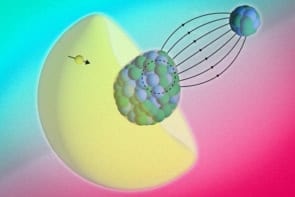
Two physicists in the US have come up with a way to use a “bubble” of ultracold atoms to measure extremely small forces. The scheme, which has yet to be tested experimentally, involves monitoring the motion of a bubble of one type of atomic gas that is surrounded by another atomic gas. The physicists claim that accelerations as small as 10-10 m/s2 could be detected — allowing the system to be used to perform new tests of the gravitational inverse-square law or to study the forces on individual atoms.
The measurements would take place in a Bose-Einstein condensate (BEC) — a gas of bosons (atoms of integer spin number) that are cooled to such low temperatures that they fall into the same quantum state. Over the past decade physicists have perfected the creation of BECs using crisscrossing laser beams to trap the ultracold atoms and using applied magnetic fields to finely tune the interactions between the atoms.
More recently, physicists have worked out ways to make BECs that contain mixtures of two different types of atoms — say “A” and “B”. By adjusting the magnetic fields such that A and B tend to repel each other, the atoms can be separated into two different phases.
‘Buoyancy’ force
Now, Satyan Bhongale of Rice University and Eddy Timmermans at Los Alamos National Laboratory have proposed a system that involves a phase-separated mixture in which one component (say B) forms a bubble in the other (Phys Rev Lett 100 185301).
Timmermans told physicsworld.com that the bubble would be subject to a force that tended to push the bubble from the middle of the trap to the edge. This “buoyancy” force, he explained, is similar to the force that causes an air bubble to rise in water. The team believes that by adjusting the laser beams that are trapping the BEC, this buoyancy force can be exactly cancelled, causing the bubble to float at the centre of the trap.
The position of the bubble could be monitored by shining two relatively weak laser beams through the bubble such that they intersect at its centre. The slightest movement of the bubble by an external force could be detected by carefully monitoring the laser beams. In some ways, the system is similar to a spirit level, which offsets the buoyancy of a bubble against the force of gravity, leading Bhongale and Timmermans to dub their system a “BEC level”.
Measuring gravity over micrometres
According to Timmermans, the level could measure gravitational acceleration to about one part in 10 billion. While this is on par with existing schemes to test gravity such as the torsion pendulum, the BEC level could reach this precision on length scales as small as a micrometre – much smaller than the millimeter distances probed by the best existing experiments. As a result, the BEC balance has the capability to reveal deviations from the familiar inverse-square law of gravitation, which could ultimately help physicists overcome one of the outstanding challenges of physics — how to unify gravity with the three other fundamental forces of nature.
In addition, Timmermans believes that the BEC level could be used to study the Casimir-Polder forces that are experienced by atoms that are near to a surface. Such forces have proved very difficult to measure but are of interest to nanotechnologists because they appear to play an important role in how atoms are organized on a surface.
While Timmermans is not aware of any experimental groups that are currently trying to build a BEC level, he believes that several groups around the world have the required experimental expertise.
One such group is led by Nobel laureate Carl Wieman at the University of Colorado and recently demonstrated that a BEC of rubidium-85 and rubidium-87 atoms could be separated into two different species (arXiv:0802.2591). Team member Scott Papp (now at Caltech) told physicsworld.com that it is “plausible that phase-separated BECs could be used for force detection”. He added that the Colorado team has already shown that such BECs are sensitive to external forces such as gravity.
However, he also observed that realizing Bhongale and Timmermans’s design in the laboratory would be “difficult, but not impossible”.



